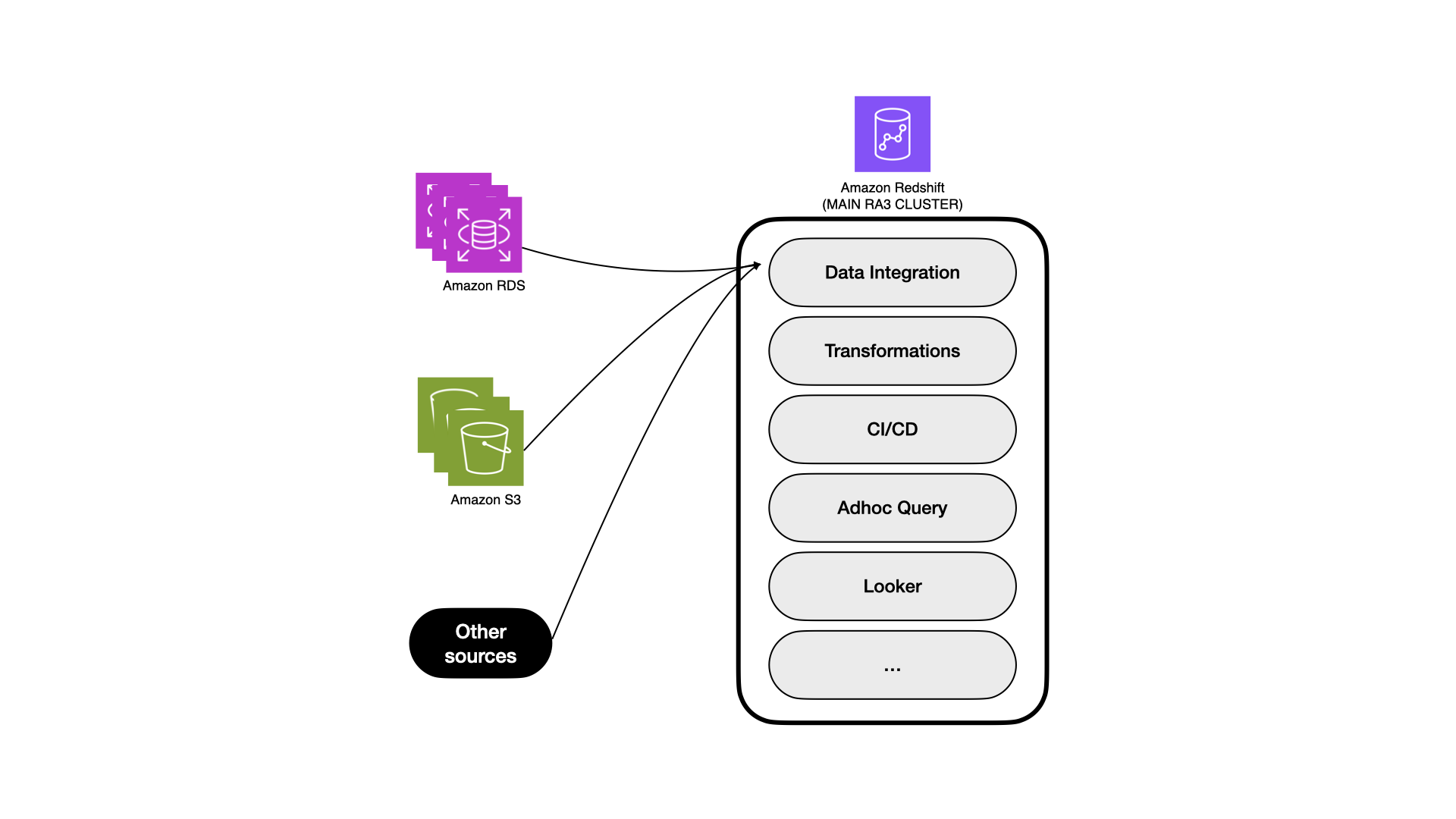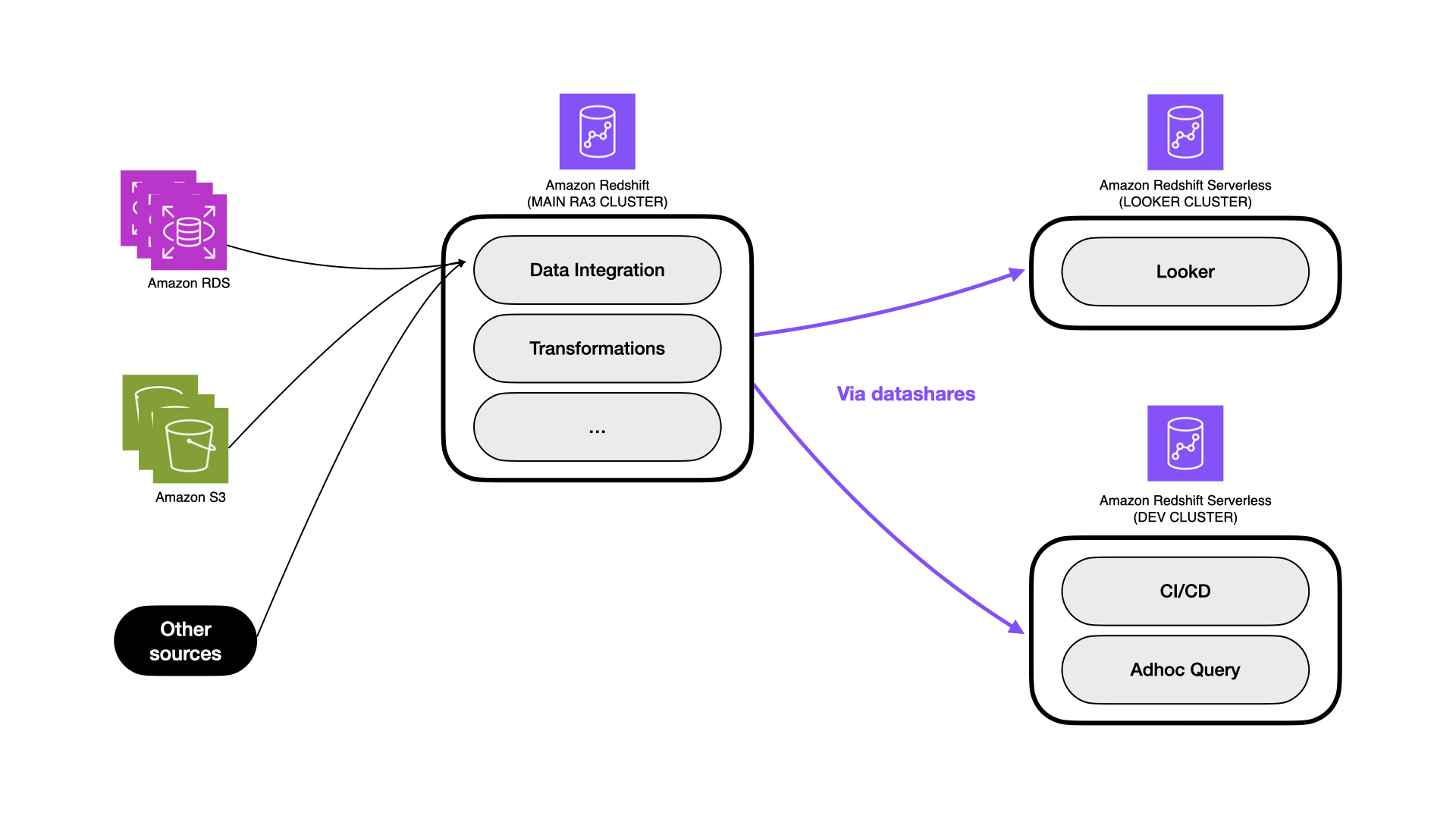AWS Big Data Blog
How Wallapop improved performance of analytics workloads with Amazon Redshift Serverless and data sharing
Amazon Redshift is a fast, fully managed cloud data warehouse that makes it straightforward and cost-effective to analyze all your data at petabyte scale, using standard SQL and your existing business intelligence (BI) tools. Today, tens of thousands of customers run business-critical workloads on Amazon Redshift.
Amazon Redshift Serverless makes it effortless to run and scale analytics workloads without having to manage any data warehouse infrastructure.
Redshift Serverless automatically provisions and intelligently scales data warehouse capacity to deliver fast performance for even the most demanding and unpredictable workloads, and you pay only for what you use.
This is ideal when it’s difficult to predict compute needs such as variable workloads, periodic workloads with idle time, and steady-state workloads with spikes. As your demand evolves with new workloads and more concurrent users, Redshift Serverless automatically provisions the right compute resources, and your data warehouse scales seamlessly and automatically.
Amazon Redshift data sharing allows you to securely share live, transactionally consistent data in one Redshift data warehouse with another Redshift data warehouse (provisioned or serverless) across accounts and Regions without needing to copy, replicate, or move data from one data warehouse to another.
Amazon Redshift data sharing enables you to evolve your Amazon Redshift deployment architectures into a hub-and-spoke or data mesh model to better meet performance SLAs, provide workload isolation, perform cross-group analytics, and onboard new use cases, all without the complexity of data movement and data copies.
In this post, we show how Wallapop adopted Redshift Serverless and data sharing to modernize their data warehouse architecture.
Wallapop’s initial data architecture platform
Wallapop is a Spanish ecommerce marketplace company focused on second-hand items, founded in 2013. Every day, they receive around 300,000 new items from buyers to be added to their catalog. The marketplace can be accessed via mobile app or website.
The average monthly traffic is around 15 million active users. Since its creation in 2013, it has reached more than 40 million downloads and more than 700 million products have been listed.
Amazon Redshift plays a central role in their data platform on AWS for ingestion, ETL (extract, transform, and load), machine learning (ML), and consumption workloads that run their insight consumption to drive decision-making.
The initial architecture is composed of one main Redshift provisioned cluster that handled all the workloads, as illustrated in the following diagram. Their cluster was deployed with 8 nodes ra3.4xlarge and concurrency scaling enabled.

Wallapop had three main areas to improve in their initial data architecture platform:
- Workload isolation challenges with growing data volumes and new workloads running in parallel
- Administrative burden on data engineering teams to manage the concurrent workloads, especially at peak times
- Cost-performance ratio while scaling during peak periods
The areas of improvement mainly focused on performance of data consumption workloads along with the BI and analytics consumption tool, where high query concurrency was impacting the final analytics preparation and its insights consumption.

Solution overview
To improve their data platform architecture, Wallapop designed and built a new distributed approach with Amazon Redshift with the support of AWS.
Their cluster size of the provisioned data warehouse didn’t change. What changed was lowering the usage concurrency scaling to 1 hour, which is in the Free Tier usage for every 24 hours of using the main cluster. The following diagram illustrates the target architecture.

Solution details
The new data platform architecture combines Redshift Serverless and provisioned data warehouses with Amazon Redshift data sharing, helping Wallapop improve their overall Amazon Redshift experience with improved ease of use, performance, and optimized costs.
Redshift Serverless measures data warehouse capacity in Redshift Processing Units (RPUs). RPUs are resources used to handle workloads. You can adjust the base capacity setting from 8 RPUs to 512 RPUs in units of 8 (8, 16, 24, and so on).
The new architecture uses a Redshift provisioned cluster with RA3 nodes to run their constant and write workloads (data ingestion and transformation jobs). For cost-efficiency, Wallapop is also benefiting from Redshift reserved instances to optimize on costs for these known, predictable, and steady workloads. This cluster acts as the producer cluster in their distributed architecture using data sharing, meaning the data is ingested into the storage layer of Amazon Redshift—Redshift Managed Storage (RMS).
For the consumption part of the data platform architecture, the data is shared with different Redshift Serverless endpoints to meet the needs for different consumption workloads.
Data sharing provides workloads isolation. With this architecture, Wallapop achieves better workload isolation and ensures that only the right data is shared with the different consumption applications. Additionally, this approach avoids data duplication in their consumer part, which optimizes costs and allows better governance processes, because they only have to manage a single version of the data warehouse data instead of different copies or versions of it.
Redshift Serverless is used as a consumer part of the data platform architecture to meet those predictable and unpredictable, non-steady, and often demanding analytics workloads, such as their CI/CD jobs and BI and analytics consumption workloads coming from their data visualization application. Redshift Serverless also helps them achieve better workload isolation due to its managed auto scaling feature that makes sure performance is consistently good for these unpredictable workloads, even at peak times. It also provides a better user experience for the Wallapop data platform team, thanks to the autonomics capabilities that Redshift Serverless provides.
The new solution combining Redshift Serverless and data sharing allowed Wallapop to achieve better performance, cost, and ease of use.
Eduard Lopez, Wallapop Data Engineering Manager, shared the improved experience of analytics users: “Our analyst users are telling us that now ‘Looker flies.’ Insights consumption went up as a result of it without increasing costs.”
Evaluation of outcome
Wallapop started this re-architecture effort by first testing the isolation of their BI consumption workload with Amazon Redshift data sharing and Redshift Serverless with the support of AWS. The workload was tested using different base RPU configurations to measure the base capacity and resources in Redshift Serverless. Base RPU ranges for Redshift Serverless range from 8–512. Wallapop tested their BI workload with two configurations: 32 base RPU and 64 base RPU, after enabling data sharing from their Redshift provisioned cluster to ensure the serverless endpoints have access to the necessary datasets.
Based on the results measured 1 week before testing, the main area for improvement was the queries that took longer than 10 seconds to complete (52%), represented by the yellow, orange, and red areas of the following chart, as well as the long-running queries represented by the red area (over 600 seconds, 9%).
The first test of this workload with Redshift Serverless using a 64 base RPU configuration immediately showed performance improvement results: the queries running longer than 10 seconds were reduced by 38% and the long-running queries (over 120 seconds) were almost completely eliminated.

Javier Carbajo, Wallapop Data Engineer, says, “Providing a service without downtime or loading times that are too long was one of our main requirements since we couldn’t have analysts or stakeholders without being able to consult the data.”
Following the first set of results, Wallapop also tested with a Redshift Serverless configuration using 32 base RPU to compare the results and select the configuration that could offer them the best price-performance for this workload. With this configuration, the results were similar to the previously test run on Redshift Serverless with 64 base RPU (still showing significant performance improvement from the original results). Based on the tests, this configuration was selected for the new architecture.

Gergely Kajtár, Wallapop Data Engineer, says, “We noticed a significant increase in the daily workflows’ stability after the change to the new Redshift architecture.”
Following this first workload, Wallapop has continued expanding their Amazon Redshift distributed architecture with CI/CD workloads running on a separated Redshift Serverless endpoint using data sharing with their Redshift provisioned (RA3) cluster.
“With the new Redshift architecture, we have noticed remarkable improvements both in speed and stability. That has translated into an increase of 2 times in analytical queries, not only by analysts and data scientists but from other roles as well such as marketing, engineering, C-level, etc. That proves that investing in a scalable architecture like Redshift Serverless has a direct consequence on accelerating the adoption of data as decision-making driver in the organization.”
– Nicolás Herrero, Wallapop Director of Data & Analytics.
Conclusion
In this post, we showed you how this platform can help Wallapop to scale in the future by adding new consumers when new needs or applications require to access data.
If you’re new to Amazon Redshift, you can explore demos, other customer stories, and the latest features at Amazon Redshift. If you’re already using Amazon Redshift, reach out to your AWS account team for support, and learn more about what’s new with Amazon Redshift.
About the Authors
 Eduard Lopez is the Data Engineer Manager at Wallapop. He is a software engineer with over 6 years of experience in data engineering, machine learning, and data science.
Eduard Lopez is the Data Engineer Manager at Wallapop. He is a software engineer with over 6 years of experience in data engineering, machine learning, and data science.
 Daniel Martinez is a Solutions Architect in Iberia Digital Native Businesses (DNB), part of the worldwide commercial sales organization (WWCS) at AWS.
Daniel Martinez is a Solutions Architect in Iberia Digital Native Businesses (DNB), part of the worldwide commercial sales organization (WWCS) at AWS.
 Jordi Montoliu is a Sr. Redshift Specialist in EMEA, part of the worldwide specialist organization (WWSO) at AWS.
Jordi Montoliu is a Sr. Redshift Specialist in EMEA, part of the worldwide specialist organization (WWSO) at AWS.
 Ziad Wali is an Acceleration Lab Solutions Architect at Amazon Web Services. He has over 10 years of experience in databases and data warehousing, where he enjoys building reliable, scalable, and efficient solutions. Outside of work, he enjoys sports and spending time in nature.
Ziad Wali is an Acceleration Lab Solutions Architect at Amazon Web Services. He has over 10 years of experience in databases and data warehousing, where he enjoys building reliable, scalable, and efficient solutions. Outside of work, he enjoys sports and spending time in nature.
 Semir Naffati is a Sr. Redshift Specialist Solutions Architect in EMEA, part of the worldwide specialist organization (WWSO) at AWS.
Semir Naffati is a Sr. Redshift Specialist Solutions Architect in EMEA, part of the worldwide specialist organization (WWSO) at AWS.